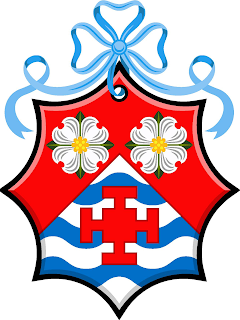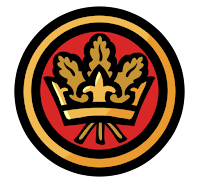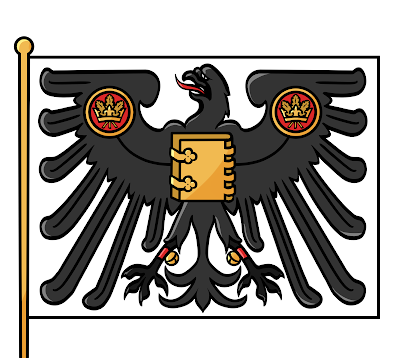 |
| Newly emblazoned arms for my daughter. Rendered by Allen Crawford, December 2023. |
Several days ago, I received a text message from my daughter detailing a rather intriguing assignment for a high school history class. What was the assignment? You guessed it, students were asked to design their own coat of arms. I contacted the instructor with an offer to deliver an age-appropriate presentation on heraldry with a specific focus on US-based heraldry. "Myth-busting heraldry: Fables, facts, and the American way," quickly became the perfect presentation title.
 |
| Having way too much fun building this slide deck. |
The main goal with this presentation is to dispel many of the common American myths regarding the subject--every family has a coat of arms, armorial devices for nobility only, etc.--and provide accurate context and facts regarding heraldry and its use in this country. I also wish to emphasize armorial assumption (a.k.a. "the American way") as this country's method in the absence of any heraldic authority. I continue to believe there is nothing more American than armorial assumption.
To engage the students with this subject, I created (what I hope will be) a fun and engaging quiz, "Name That Shield," to underscore how coat armor creates identity. For example, I'll share the arms of Harvard, the Episcopal Church, the arms of the sovereign of the United Kingdom, and so forth to see which arms are immediately recognizable. Like any good teacher, following the exercise we will unpack the reasons pertaining to how and why the students were able to name the bearer of those shields. My hope is students will begin to understand that simple and perspicuously designed arms hold power in our memories, serving as timeless abstract symbols of identity.
Perhaps the most exciting portion of the presentation, at least for me, will be guiding the students through the design and creation process. To help bring this exercise to life, I created a coat of arms for the school itself to keep everything close to home in the minds of the students.
Fuqua School is a private, K-12 school located in Prince Edward County, Virginia. The school is named after its benefactor, Mr. J.B. Fuqua (1918-2006) whose generous philanthropy helped propel the school to live out its mission to provide excellence in rural education.
.PNG) |
| Proposed arms for Fuqua School designed by the Author and rendered by Lucas Hofmann, November 2023. |
Given several limitations, I wanted to incorporate in these armorial bearings a geographical reference for further customization. Formed in 1754, Prince Edward County is named for Prince Edward, the Duke of York and Albany (1739-1767). To reference the county's namesake, I selected a simple ancient coronet for clear identification.
For additional reference, I selected three sheaves of wheat to identify the location of both Farmville and Prince Edward County. The county's seal contains wheat, but also Mr. Fuqua's origins of farming and agriculture fits nicely as well.
 |
| Roundel showing identification in the proposed arms for Fuqua School. Rendered by Lucas Hofmann, November 2023. |
Having three sheaves of wheat enfiled by the ancient coronet contained in a roundel using red and gold provided a logical solution for using red while also locating the school geographically--a design scheme Pierre de Chaignon la Rose (1872-1941) created for his devisal of arms for Mundelein College in 1930. For the college, la Rose used two roundels on the wings of a phoenix rising from the flames to reference the religious community's foundation as well as the corporate sole. I believe this arrangement was perfect for this new design.
 |
| The armorial flag of Fuqua School, rendered by Lucas Hofmann, November 2023. |
Through the American Heraldry Society, I received helpful feedback regarding my design. One critical learning outcome: falcons in heraldry are typically "belled and jessed," and this blazon was new to me. Adding bells tied with strings on the legs helps identify the bird as a falcon, while referencing the ancient practice of falconry at the same time.
I was most impressed with how the designed turned out in full color--especially when seen as an armorial flag. I can simply see this flag unfurled and flying on the school's flagpole any day now.
Why should schools consider adopting arms? While it's my belief that heraldry was never intended to serve as a corporate brand as defined in the business literature, institutional heraldry serves as a distinctive expression of the mission and values of that brand. In an age when schools, colleges, and universities (especially private ones) are constantly rebranding in order to own marketshare for enrollment needs, schools using arms provide a static symbol for countless generations of alumni and friends of their institutions. A well designed shield creates a dignified emblem for the entire community to embrace and inhabit. Additionally, arms provide decoration for school memorabilia, especially when otherwise using the legal corporate seal should be reserved for authentication. Heraldry also elevates any school or academic ceremony with dignity while creating new traditions at the same time. Ultimately, a school's coat of arms becomes a timeless symbol of pride for the entire community, a testament to the carrying power of an idea birthed in the 12th Century. I believe these are among the best reasons for academic institutions to adopt and use arms.
Sharing my love of heraldry, and how arms provide unique identification, is work I'll never grow tired of doing; I'm excited for next week. While it remains to be seen if the school likes, much less adopts this design of arms, I enjoyed the process and the creative stimulation. I'll certainly post any updates in the future.
Blazon of proposed arms for Fuqua School: Argent, on the breast of a falcon displayed sable belled and jessed proper, a closed book with two clasps Or, on each wing a torteau edged Or charged with three sheafs of wheat enfiled by an ancient coronet all Or.









0 comments:
Post a Comment